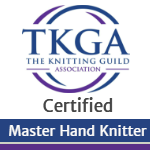Grafting two pieces of knitting can be pretty complicated. All Kitchener stitch is grafting, but not all grafting is Kitchener stitch.
Kitchener stitch applies to stockinette stitch, and that’s it.
BUT, we may want to graft things other than stockinette!
Today I want to take a look at the basics of grafting — and what is happening in the knitting.
There are two distinct situations for grafting. Typically, we are grafting a bind off edge to a bind off edge. This is where Kitchener typically applies. (Sock toes, a shoulder seam, etc.) But, sometimes we may want to graft a cast on edge to a bind off edge. (A cowl knit flat and then joined to a tube, for example.)
When grafting BO edge to BO edge, there is going to be a half-stitch jog at the graft. We begin with the same number of loops on each needle. See this:

The top of the graft wants to “finish” the row above, and so needs two half loops to create the base of a stitch. ( We need one more loop on the top needle than the bottom needle in order to have the right number of “two-half-loops spaces.”) But our loops from the BO edge on top are not two half loops, but whole loops of stitches. This creates the half-stitch jog when grafting here. To begin we take the first top loop and treat the first half of it like a set of two half-loops in order to get the stitches to line up, and to account for not having the extra half loop that we need. (Kitchener setup steps: Purl front st, leave on, knit back st, leave on.)
But when grafting a CO edge to a BO edge, the direction of knitting is maintained across the graft. The loops at the base of the CO edge that we release from a provisional CO are all half loops from the base of stitches. And we have one extra loop here than we have on the bottom needle. (To create that last loop, the tail is looped over the needle and secured. See the very left edge of the orange stitches here. That last little tail should be woven into the selvedge to secure that last loop.) So we have what we need to create a seamless graft. No half-stitch jog!! (I’ll have a post on this specifically next week.)

You can perhaps then see from our photos above — a grafted row actually *completes* two rows of knitting. Yes, you are creating only one row of knitting with your grafted loops, but we are telling the base loops above what they wanted to grow up to be — and so we are also finishing the row from those loops. (That first row of loops in orange were the cast on stitches! The first row of actual knitting is the next row. So grafting “finishes” those cast on stitches.) They were “stitches in waiting,” if you will. In these illustrations it is all stockinette (Kitchener!), so the grafted row is knit stitches and the “finished” stitches above are also knit stitches. This will not be the case for a particular grafting situation if you have something other than stockinette. And that’s where the complications come in.
Stay tuned, on Friday I will have a post on the special case of grafting 1×1 ribbing. Coming up later next week will also be two posts on grafting the CO to BO edge in more detail, and on grafting seed stitch specifically.
Happy Knitting!




